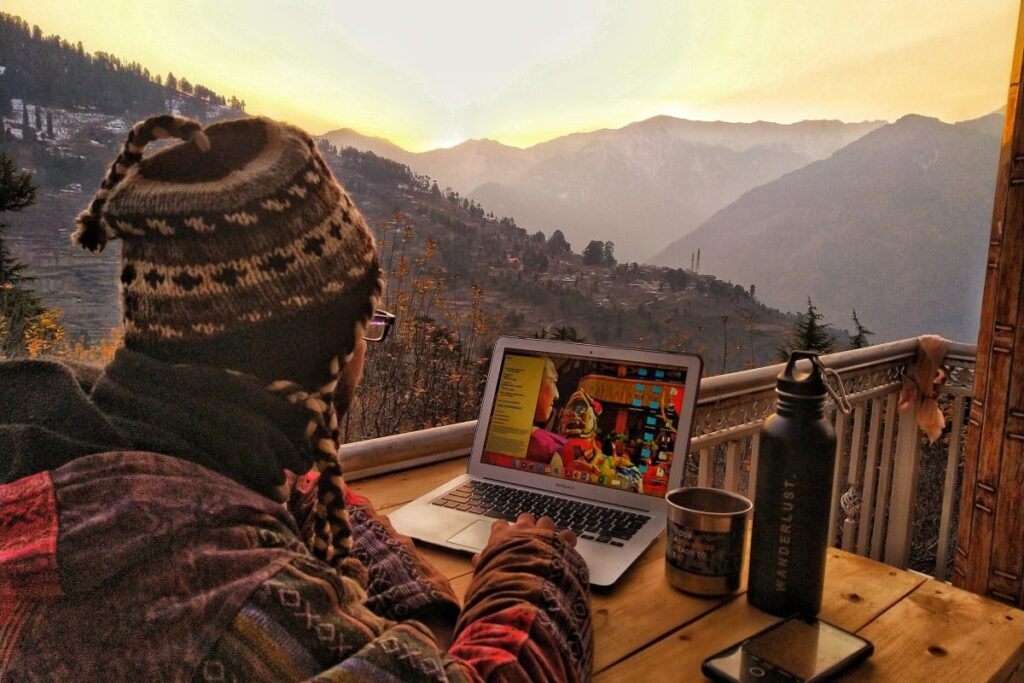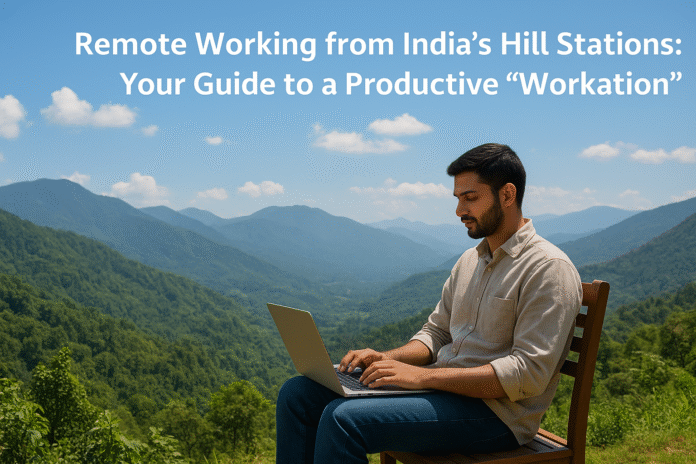The dream of swapping a bustling city office for a serene workspace with a view of snow-capped peaks has never been more achievable. With the rise of remote work, the concept of a “workation” — a blend of work and vacation — has taken off, and India’s hill stations are at the forefront of this trend.
Moving beyond the occasional holiday, professionals are now seeking to live and work from the mountains for weeks or even months. This shift is driven by a desire for a better work-life balance, an escape from urban pollution and noise, and a chance to recharge amidst nature. But is it practical? Can you truly maintain your productivity while living on a mountain? This detailed guide will help you navigate the logistics, costs, and best locations for your remote working adventure from India’s stunning hill stations.
The Rise of the Digital Nomad in India
The post-pandemic world has normalized remote work, leading to a surge in the digital nomad lifestyle. India, with its diverse geography and affordable cost of living, has emerged as a prime destination. A 2025 study from JoinYourTrip noted a significant increase in the number of Indian professionals and international travelers choosing to work from locations that offer both connectivity and natural beauty.
Hill stations, in particular, are gaining popularity for several reasons:
- A Welcome Escape: The clean air and tranquil environment provide a stark contrast to city life, offering a powerful antidote to stress and burnout.
- Affordable Living: Compared to major Indian metro cities, the cost of long-term accommodation, food, and local travel in many hill stations can be surprisingly low.
- Reliable Connectivity: While once a challenge, reliable internet is now available in many popular mountain towns, with fiber and 5G networks expanding rapidly.
Top Hill Stations for Remote Work in 2025
Choosing the right location is the most critical decision for your workation. Here’s a breakdown of some of India’s best hill stations, considering connectivity, cost, and lifestyle.
1. McLeod Ganj, Himachal Pradesh

Known as “Little Lhasa,” McLeod Ganj is a vibrant town with a unique blend of Tibetan culture and natural beauty. It has a strong community of creatives and remote workers.
- Connectivity: While 5G is not yet universal, the main town and nearby areas like Dharamkot and Bhagsu have a good density of cafes and guesthouses with reliable Wi-Fi. Fiber internet is increasingly common in long-term rentals.
- Budget: McLeod Ganj is very affordable. A one-month stay in a homestay or guesthouse with food and Wi-Fi can range from ₹25,000 to ₹35,000. Rent for a small apartment can be even cheaper.
- Lifestyle: The town offers a relaxed, spiritual vibe. You can attend yoga and meditation classes, explore monasteries, and enjoy trekking to places like Triund on weekends.
- Safety: McLeod Ganj is considered very safe for both men and women, including solo female travelers. The presence of a strong international community and a respectful local culture contributes to a secure environment.
2. Manali & Old Manali, Himachal Pradesh
A classic favorite for tourists, Manali has a quiet, bohemian side that’s perfect for remote workers.
- Connectivity: Old Manali is particularly well-equipped with cafes and guesthouses offering Wi-Fi. Many long-term rentals now have dedicated fiber internet connections. However, network coverage can be patchy outside the main town. Expect speeds in the range of 10-40 Mbps.
- Budget: Similar to McLeod Ganj, a one-month stay is highly affordable. You can find comfortable homestays for ₹20,000-₹30,000 per month, which often includes food and laundry services.
- Lifestyle: Manali is an adventurer’s paradise. When you’re not working, you can indulge in activities like trekking, paragliding, river rafting, and exploring the surrounding villages.
- Safety: The area is generally safe, but like any tourist hub, it’s wise to be cautious at night, especially in crowded areas.
3. Mussoorie & Landor, Uttarakhand

Known as the “Queen of the Hills,” Mussoorie offers a mix of colonial charm and modern amenities. The quieter, more upscale area of Landour is a haven for remote workers.
- Connectivity: Mussoorie has a fairly developed infrastructure. You can find multiple cafes with Wi-Fi, such as Little Llama Cafe and Cafe By The Way. Landour’s guesthouses and homestays also offer decent internet.
- Budget: Mussoorie is slightly more expensive than Manali or McLeod Ganj due to its established reputation. A monthly budget for accommodation and food could be in the range of ₹30,000 to ₹45,000.
- Lifestyle: It’s an ideal place for those who love walking. The Mall Road, while bustling, is great for a stroll. The surrounding forests offer quiet trails for a peaceful work break.
- Safety: Mussoorie is known for being a safe and family-friendly destination.
Finding a stay that blends comfort, reliable internet, and a peaceful atmosphere is key for remote workers. Options like this month-long workation package are designed for professionals who want to stay productive while enjoying the charm of the mountains.
4. Rishikesh, Uttarakhand
A spiritual hub on the banks of the Ganges, Rishikesh is a great option for those who want to blend work with wellness.
- Connectivity: The Tapovan and Laxman Jhula areas are hotspots for digital nomads, with many hostels and cafes offering reliable internet. Several co-working spaces have also emerged with river views.
- Budget: Rishikesh is one of the most budget-friendly options on this list. A monthly living cost, including accommodation in a hostel or guesthouse and food, can be as low as ₹15,000 to ₹25,000.
- Lifestyle: The town offers a unique blend of spirituality and adventure. You can attend yoga classes, go for a dip in the Ganges, and enjoy adventure sports like river rafting on weekends.
- Safety: Rishikesh is a safe city, particularly in the tourist areas. The spiritual environment fosters a sense of community and security.
5. Ooty, Tamil Nadu
For those who prefer the tranquility of the South, Ooty, the “Queen of Hill Stations,” is a charming choice.
- Connectivity: Ooty has a reasonably developed network infrastructure. While it may not have the lightning-fast speeds of a metro, many hotels and guesthouses offer Wi-Fi. Local service providers are also offering fiber broadband options.
- Budget: Ooty is a relatively affordable destination. A monthly budget of ₹25,000 to ₹40,000 should be sufficient for a comfortable stay.
- Lifestyle: Ooty is a beautiful place for nature lovers. You can explore vast tea plantations, go boating on the lake, and take the historic Nilgiri Mountain Railway.
- Safety: Ooty is a peaceful and secure destination, known for its friendly locals and safe environment for travelers.
Essential Practical Tips for Your Hill Station Workation
Going from a city to a mountain for remote work requires careful planning. Here’s what you need to know to ensure a smooth and productive experience.
1. Budgeting and Costs
Your budget will depend on your lifestyle, but here’s a general breakdown of monthly expenses:
| Expense Category | Budget-Friendly (₹) | Mid-Range (₹) |
| Accommodation (Homestay/Guesthouse) | 10,000 – 18,000 | 18,000 – 30,000 |
| Food (Local eateries/Cooking) | 5,000 – 8,000 | 8,000 – 15,000 |
| Internet & Mobile | 1,000 – 1,500 | 1,500 – 3,000 |
| Local Travel & Activities | 3,000 – 5,000 | 5,000 – 10,000 |
| Total Monthly Budget | ~₹19,000 – ₹32,500 | ~₹32,500 – ₹58,000 |
This is just a rough estimate; costs can vary widely. Places like Rishikesh and McLeod Ganj lean towards the budget-friendly side, while Mussoorie and Manali might be closer to the mid-range.
2. Connectivity: Your Lifeline
This is arguably the most crucial factor for a workation.
- Primary Internet: Always ask your host or accommodation provider about their internet situation. A fiber-optic connection is ideal. Confirm the speed and reliability before you book.
- Backup Plan: Never rely on a single source. Keep a mobile hotspot with a good data plan from a reliable provider like Airtel or Jio. Check the network coverage in the specific area you plan to stay in.
- Co-working Spaces: Many hill towns now have dedicated co-working cafes. While they might cost a bit, they offer a professional environment, fast internet, and a chance to network. Shimla, for instance, has several co-working spaces with day passes and monthly memberships.
3. Transportation & Accessibility
- Reaching the Hills: Most hill stations are well-connected by road. Buses (state-run or private) and taxis are the most common way to get there. The nearest airports are often in the plains, like Chandigarh for Himachal or Dehradun for Uttarakhand.
- Getting Around Locally: Public transport is limited in most remote hill stations. Taxis and local buses are available, but for flexibility, renting a two-wheeler or having a personal vehicle is a great option.
4. Safety & Health
- Monsoon Risks: Be mindful of the monsoon season (July to September). Heavy rains can trigger landslides and road closures, making travel difficult and sometimes dangerous. Check weather forecasts and road conditions before you travel.
- Health Precautions: Carry a basic first-aid kit. Pack appropriate clothing for the climate, as temperatures can drop suddenly, especially at higher altitudes.
- Personal Safety: While hill stations are generally safe, exercise the same precautions you would anywhere else. Be aware of your surroundings, especially at night.
5. Lifestyle & Productivity
- Establish a Routine: The relaxed pace of the mountains can be a double-edged sword. Establish a consistent work routine to stay productive.
- Embrace the Vibe: Don’t just stay indoors. Use your work breaks to your advantage. Go for a short walk, sit outside with your coffee, or simply watch the clouds. This is the essence of a “workation.”
- Engage with the Community: Whether it’s the local cafes, yoga classes, or trekking groups, connect with other remote workers and locals to enrich your experience.
Future of Remote Work in the Hills
The trend is here to stay. As internet infrastructure improves and more people embrace the flexible work model, hill stations will continue to evolve into hubs for digital nomads. We can expect to see:
- More specialized co-living and co-working spaces.
- Improved 5G connectivity even in more remote areas.
- Local economies adapting to cater to the needs of remote workers.
This presents a unique opportunity for people to not only find a better work-life balance but also to contribute to the local economies of these beautiful regions.
Conclusion: Your Mountain Office Awaits
Remote working from India’s hill stations is no longer a fantasy—it’s a viable and enriching way to live and work. By planning your budget, securing your connectivity, and choosing a place that aligns with your lifestyle, you can successfully trade your cubicle for a cabin with a view.
The mountains offer more than just a change of scenery; they offer a change of pace. They teach you to slow down, to appreciate the little things, and to find inspiration in nature. So, pack your bags, fire up your laptop, and get ready for the most rewarding work experience of your life.
Also, check out our travel blog: Bali Adventure Awaits: Your Full Travel Guide




